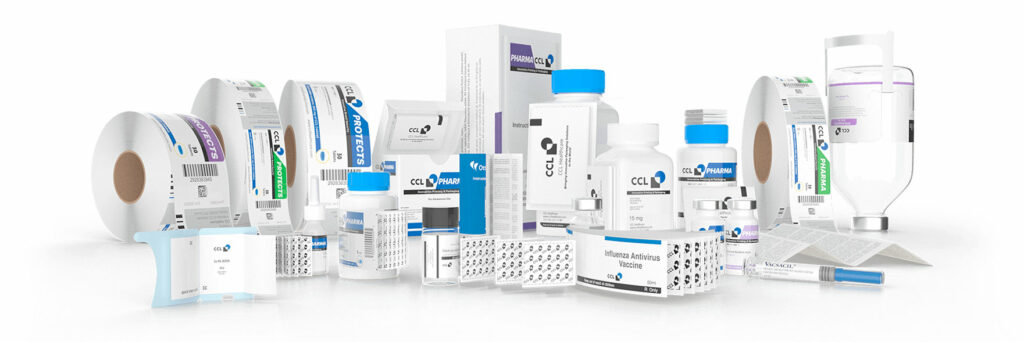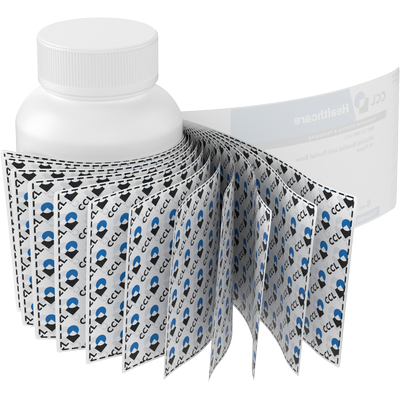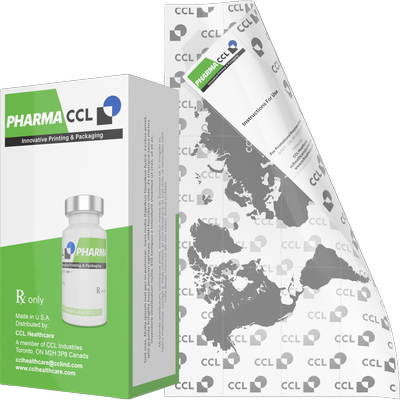The basics of Extended Content Labels
Extended content labels, also known as, expanded content labels, multi-ply labels, peel-back or resealable labels, booklet labels and fold-out labels are found on various pharmaceutical products and play a vital role in protecting the safety of your customers. Many products with potentially dangerous substances have these booklet labels, which provide consumers with a vast range of information. Some products also come with complex instructions that need the space only wrap-around labels can provide.
ECLs can be life-saving and help your customers gain more value from your products. This makes it essential to familiarize yourself with them. We’ve outlined some key features of ECLs and their purpose. Check out what makes an effective ECL, so you know the best practices to consider when you design yours.

Alternative Names for Extended Content Labels
- Multi-panel labels
- Fold-out labels
- Extended content labels
- Peel and reveal labels
- Booklet labels
- Interactive labels
- Informational labels
- Product information labels
- Expanded text labels
- Label inserts.
- Multi-page expanded content labels
- Fold-out booklet labels
- Information booklet labels
- Peel and read booklet labels
- Multi-panel booklet labels
- Product information booklet labels
- Comprehensive booklet labels
- Extended content booklet labels
- Layered labels
- Multi-layer labels
- Ply labels
- Duplex labels
- Triplex labels
- Peel and reveal labels
- Fold-out labels
- Multi-part labels
- Multi-component labels.
What Are Considered Expanded Content Labels?
Expanded content labels (ECLs) are a type of label that provides additional space for important product information, such as safety warnings, usage instructions, ingredients, and regulatory information, that cannot fit on a traditional label due to space limitations.
 ECLs are usually multi-panel or multi-page labels that can be folded out or peeled open to reveal additional information. They are commonly used in industries that require detailed product information, such as pharmaceuticals, cosmetics, and food and beverage.
ECLs are usually multi-panel or multi-page labels that can be folded out or peeled open to reveal additional information. They are commonly used in industries that require detailed product information, such as pharmaceuticals, cosmetics, and food and beverage.
Expanded content labels are an effective way to provide consumers with essential information about the product they are purchasing, while still maintaining a clean and simple label design. They can help manufacturers comply with regulatory requirements and improve customer satisfaction by ensuring that important product information is easily accessible.
Expanded content labels are leaflets s or booklets that are attached to the exterior of the packaging for items with potentially dangerous ingredients. ECLs typically take the form of multi-page booklet, multi-layer labels, multi-ribbon leaflets, or a single layer label that wraps around the container. This makes these labels physically distinctive and capable of holding far more information than the typical label affords, as they have more space.
ECLs are vital packaging components and make your product more accessible to users. Expanded content labels may also legally require you to sell your product. Choosing the right form can help you enhance your product with your ECL while enticing your users to use your product.
Types of Extended Content Labels
There are several types of extended content labels that you can choose from depending on your needs. Some formats may be more accessible to your customers. Others might be better suited to presenting the information you wish to share because they have more space.
Some of the most popular formats for ECLs include two major categories: booklet labels and smooth peel labels. You can choose from several subtypes of expanded content labels within each type. Some of these may be better suited to your needs than others, so it’s worth considering all your options to choose the right one for your business.
Booklet Labels
As the name suggests, booklet labels carry significant information about your products. Given their size, they can be relatively expensive, making them potentially outside of your budget. You may not require ECLs to carry the amount of information these can carry. They can take several different forms of labels that offer more space, including the following:
Offset Inserts
Offset inserts are one of the most popular types of booklet labels. These types of expanded content labels come in four basic forms:
- Folded insert: These take the form of a folded piece of paper with information printed on its sides. They can take a variety of shapes and be folded to conform to your packaging needs.
- Bound insert: Bound inserts can be used outside the packaging of an item and mays be made of more durable laminated or artificial paper.
- Single panel inserts: These inserts are commonly used to share promotions with customers, such as coupons. These expanded content labels may take the form of leaflet labels.
- Encapsulated or Data pack: A data pack is a booklet or a pamphlet and is ideal for situations in which it must survive exposure to moisture.

Flexographic booklet label inserts
Flexographic booklet label inserts are less expensive than other booklet label types, making them more appropriate for many products with less information to share. These expanded content labels include two main types of forms:
- Single panel inserts: Single panel inserts are typically used to share coupons with clients.
- Plow fold insert: These multi-panel inserts are resilient to damage and can share vital information in an attractive format.
Smooth Peel Labels
Smooth peel labels form the other major type of extended content label. These carry less information but less space on an item’s packaging. They’re also less expensive than different types of ECLs. The main types of smooth peel labels fall into the following categories:
Flexographic Smooth Peels
These labels are typically added to product packaging to comply with health and safety regulations. They can more than double the amount of space for your labels. They’re also easy to apply at scale and resilient, making them a cost-effective solution for increasing your label space.
- 2-ply: These labels can contain up to 12 pages of information. They open along a hinge and are highly convenient for consumers and manufacturers. These are popular label choices for resealable labels.
- Extended ply: These expanded content labels are used for products that require more than four pages of information. They are made using a four-color process that allows printers to create vibrant, beautiful, and easy-to-read designs.
- Wrap: These labels are rectangular and are wrapped around all or part of a bottle or jaw. They are very useful for making colorful and durable labels with more graphics than alternatives.
Flexographic Peel Free
These expanded content label labels easily peel off a package and don’t leave behind a tacky residue like others. These are excellent for presenting information and special offers to customers. These are typically found in dry release peels and dry release labels.
What Products Contain Extended Content Labels?
Given their utility, extended content labels are common sights for today’s consumers. A wide range of products can use multi ply labels, including the following:
- Medications and pharmaceuticals
- Vitamins and minerals
- Nutraceuticals
- Chemicals
- Cosmetics
- Lubricants
- Weed control products
- Information about clinical trials
You may wish to experiment with your ECLs to choose the right one for your needs and customer expectations. Some products are better suited to fold out labels. Other types of packaging can benefit from a pressure sensitive label, especially if they require special care.
What Are The Benefits of ECLs?
ECLs offer numerous benefits to users along with the companies that issue them. By knowing these, you can better use ECLs the next time you encounter them.
Types of Content Found in ECLs
Extended content labels typically contain additional content, which helps to identify them for audiences. Some of the most common applications for these extended content labels include:
- Medication Guides
- Drug Facts
- Nutritional Facts
- Supplment Facts
- Instant redeemable coupons
- Rebate instructions
- Promotional products or items
- Translations in multiple languages
- Special Instructions
- Interesting Informational
- Sweepstakes opportunities
- Recipes and ingredients
What ECL’s Do for Pharmaceutical Packaging
Expanded content labels provide extensive information about pharmaceutical products. These can provide users with a wealth of information that allows them to use your product safely and effectively. An ECL label can include cautionary messages that warn users about potentially dangerous ingredients that can harm their health.
Protect Your Brand While Meeting Industry Regulatory Requirements With Booklet Labels
One of the most effective uses of an expanded content label is to meet regulatory requirements. Booklet labels contain much additional “real estate.” An expanded content label includes extra space to hold critical information regulators require producers to include.
Pharmaceutical producers have many options when choosing an extended product content label. They can choose labels that preserve their branding while including all the required information. Expanded content labels can also include QR codes for more information about the product or promotional offerings online.
Educate Users With Expanded Content Labels In Their Languages
Many pharmaceutical product manufacturers will want to educate users about their products but sell to an international audience. However, they have little opportunity to do so on an item’s packaging, as this will typically be in English or the main local native language.
An ordinary label won’t have enough room to hold one (or several) translations of complex scientific content you need to share with your customers. An expanded content label can provide you with this added space and the following opportunities. Extended content labels can allow you to include multiple translations of your safety information. These can help your products reach a wider audience at a minimal cost, as the ECL can be attached to the exterior of your existing packaging.
What to Consider When Designing Expanded Content Labels
You’ll want to consider several factors before designing expanded content labels before committing. Once you do so, you can create the optimal label design for your needs.
Supporting Your Marketing
ECLs can be designed to support your marketing efforts. Any additional ECLs added to a product’s packaging are an opportunity to further engage with your customer and showcase your brand to the world in multiple languages, from the design to the content itself.
Package Durability
What kinds of stressors will your package be exposed to, and what regulatory requirements will they face during shipping? You’ll want to choose a more rugged ECL label if it can face moisture, high heat, or other physical or environmental extremes. However, you can use ordinary labels and take advantage of their benefits if you don’t expect your product to face these challenges.
What to Consider When Ordering Expanded Content Labels
If you’re ordering expanded content labels for your business, you’ll want to consider your regulatory needs. What regulatory information are you expected to share with your customers? Then, you’ll want to consider the design and artwork you want to use. Consider which designs best convey the information and experience you want for them and how an extended content label will perform compared to ordinary labels. Then work with a manufacturer you can trust to deliver ECL labels of the highest quality.
For more information about Extended Content Labels that
CCL Healthcare manufactures please click the button below.